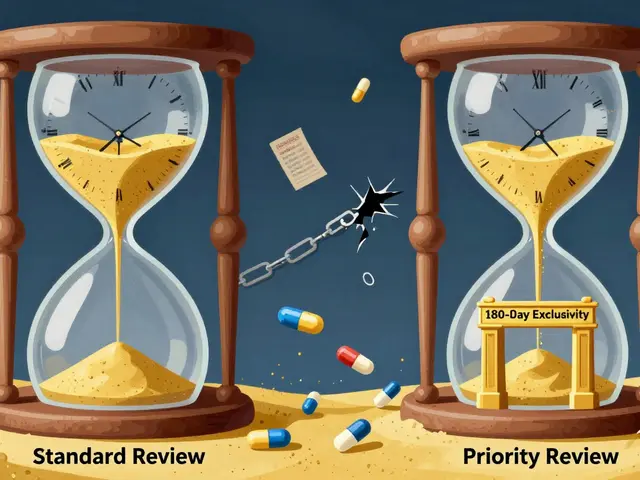
You start a new birth control or take the morning‑after pill and then-spotting out of nowhere. Annoying? Yep. Scary? Usually not. Breakthrough bleeding with levonorgestrel happens a lot, and in most cases it settles once your body adapts. The trick is knowing what’s normal, what actually helps, and when to get checked. I learned this the hard way when my partner Lisa switched to a new IUD-those first months tested our patience, not our relationship.
- TL;DR: Spotting is common after starting or using levonorgestrel methods, especially in the first 3-6 months or after emergency contraception. It’s usually temporary.
- Quick fixes that help: strict pill timing, a 5-7 day NSAID course, or a short estrogen add‑back (if safe). Rule out pregnancy first.
- Red flags: soaking a pad/hour for 2+ hours, severe pain, fever, pregnancy symptoms, missing IUD strings-get medical care.
- By 6 months with an LNG IUD, bleeding typically lightens a lot; by 1 year, many have light periods or none.
- Med interactions (like enzyme inducers) and missed pills cause many bleed-through episodes-fixing those often fixes the bleeding.
Why levonorgestrel causes breakthrough bleeding (and what’s normal)
First, a quick refresher. levonorgestrel is a progestin used in several ways: the morning‑after pill (emergency contraception), hormonal IUDs (Mirena, Kyleena), the progestin‑only pill (mini‑pill), and in many combined pills (with ethinyl estradiol). Different formats, same hormone family, similar bleeding logic.
What’s going on under the hood? Progestins thin the uterine lining and make the blood vessels a bit fragile while your body adjusts. That thinning is great for lighter periods long‑term, but in the early phase it can mean random spotting. Add in missed pills (a small hormone dip = a mini withdrawal bleed) or interacting meds that lower hormone levels, and you get more bleed‑through.
What’s normal by method:
- LNG IUD (Mirena, Kyleena): Common to have irregular spotting and light bleeding for 3-6 months. Cramping may tag along early. By 6 months, cycles usually settle; by 12 months, many report very light bleeding or none (amenorrhea is common with Mirena). This pattern is described consistently in product information and major guidelines.
- Progestin‑only pill (mini‑pill): Irregular spotting is very common in the first months. Timing matters-take it at the same time daily. Even a few hours off can trigger spotting for some brands.
- Combined pill/patch/ring containing levonorgestrel: Breakthrough bleeding can show up in the first three packs (especially if you’re on lower estrogen doses, like 20 mcg EE). Skipping placebo pills to run packs back‑to‑back can cause “breakthrough” bleeds at random early on, which usually settles with consistent continuous use.
- Emergency contraception (LNG EC): About a third of users notice spotting or an early/late period in the next 1-2 weeks. Your next period often comes within a week of expected, but can be earlier or up to a week late. If it’s more than a week late, take a test.
Other things that can add to bleeding:
- Missed doses or variable timing (big for the mini‑pill).
- Med interactions: enzyme inducers like some seizure meds (carbamazepine, phenytoin), rifampicin/rifabutin, and St John’s Wort can lower hormone levels and cause bleeding and contraceptive failure risk.
- Smoking (affects estrogen stability and blood vessels), recent childbirth, perimenopause.
- Infections (chlamydia, cervicitis), pregnancy (including ectopic), thyroid issues, uterine causes (polyps, fibroids) that may need assessment.
Rules of thumb:
- If you’re within the first 3-6 months of a new hormonal method and the spotting is light and not painful, it’s usually okay to watch and use quick fixes.
- If bleeding is heavy, prolonged, painful, or you have pregnancy symptoms, test and see a clinician.
- If you’re on the mini‑pill and timing is all over the place, fix timing first; that alone solves a lot.
| Method | How common is unscheduled bleeding early? | When it usually settles | What often helps | When to check in |
|---|---|---|---|---|
| LNG IUD (Mirena, Kyleena) | Very common first 3 months; many notice spotting/light bleeding | 3-6 months; by 12 months, bleeding usually much lighter; amenorrhea common with Mirena | NSAIDs for 5-7 days; short estrogen add‑back if appropriate; time | Heavy bleeding, severe pain, fever, strings missing/too long, pregnancy symptoms |
| Progestin‑only pill (mini‑pill) | Common in first 1-3 months; worsens with late/missed pills | By 3-6 months with consistent timing | Set alarms; NSAIDs; consider switch to combined pill or IUD if persistent | If bleeding persists beyond 3-6 months or is heavy/painful; rule out pregnancy/STIs |
| Combined pill/patch/ring (with LNG) | 20-30% in first 3 packs, more with low‑dose estrogen | After 3 packs or steady continuous use | Don’t miss doses; consider 30-35 mcg EE; continuous/extended cycling with planned breaks | If breakthrough bleeds continue after 3 packs despite perfect use |
| LNG emergency contraception | About one‑third notice spotting/shifted period within 1-2 weeks | Next cycle usually normal; may be early or up to a week late | Track cycle; test if period >1 week late | Persistent heavy bleeding, severe pain, or late period with pregnancy symptoms |
Why trust this pattern? It lines up with major guidance: CDC Selected Practice Recommendations (2024) describe early unscheduled bleeding as common with hormonal methods; the FSRH (2023) advises initial watchful waiting plus simple treatments; Mirena and Kyleena product info report irregular bleeding early that improves over time; and Australian RACGP guidance mirrors the same trajectory.

Stop the spotting: fixes you can try today
Before you reach for anything, rule out pregnancy with a home test if your period is late or the bleeding seems off. After that, use a simple plan.
- Track for two weeks. Note days of spotting/bleeding, pain, sex, missed pills, and meds. You’ll spot patterns fast, and your GP will love the clean data.
- Nail your timing.
- Mini‑pill: set a daily alarm and carry a spare strip. Even a 3-4 hour delay can trigger spotting for some formulations.
- Combined pill: take at the same time daily; if you’re running packs together, expect a few breakthrough days early on-don’t panic.
- IUD: there’s no “timing” to fix, so skip to step 3.
- Try a short NSAID course during the bleed. If you’re safe to take them (no ulcers, kidney issues, late pregnancy, or bleeding disorders):
- Ibuprofen 400 mg three times daily for 5-7 days, or
- Naproxen 500 mg once, then 250 mg twice daily for 5-7 days.
NSAIDs reduce prostaglandins, which calms the endometrium and often stops the drip within a few days. This approach appears in CDC and FSRH advice for unscheduled bleeding.
- Consider a short estrogen add‑back (if safe for you). This is for people on the mini‑pill or with an LNG IUD who are eligible for estrogen (no migraine with aura, no VTE history, not smoking over 35, etc.). A clinician may suggest 10-20 days of a low‑dose combined pill (for example, 20-30 mcg EE with a progestin) to stabilize the lining. This is a common, guideline‑supported trick; don’t DIY without a quick check‑in with your GP.
- Heavy flow? Ask about tranexamic acid. If the issue is volume, a doctor may prescribe tranexamic acid (e.g., 500 mg three times daily for up to 5 days during bleeding). It helps the blood clot in the uterus. Skip it if you have a high clot risk-your clinician will screen you.
- Fix the root causes.
- Check for interactions: seizure meds, TB antibiotics, St John’s Wort can cut hormone levels and cause bleeding; your GP or pharmacist can map the risk.
- Test for STIs if you have new partners or symptoms (discharge, pelvic pain).
- Address thyroid or uterine issues if suggested by exam/history.
- Optimize or switch methods if you’re miserable.
- Combined pill user with bleeding on 20 mcg EE? A 30-35 mcg EE option or a different progestin can help.
- Mini‑pill user tired of timing stress? A ring, patch, or IUD can remove the daily deadline.
- LNG IUD user still bleeding after 6 months? Get checked for strings position, infections, and other causes; some switch to a different IUD or a non‑hormonal copper IUD if they prefer predictable periods.
- Emergency contraception users:
- Expect a timing wobble in your next bleed. Use pads/liners if needed.
- If your period is >7 days late after LNG EC, take a pregnancy test.
- If weight/BMI is high or you’re on enzyme‑inducing meds, LNG EC may be less reliable; in future, a copper IUD or ulipristal (if you’re not actively on hormonal contraception) can be more effective-ask your pharmacist or GP in Australia; brands and availability differ.
Pro tips from the trenches:
- Give it time, but set a deadline. For most methods, 3 months is a fair trial; 6 months for LNG IUDs. If you’re still unhappy then, revisit the plan.
- Plan B bleeding is not a period reset button. It just shuffles the deck for one cycle.
- Low iron equals low energy. If bleeding’s been heavy, ask for a ferritin test and top up iron if needed.
- Avoid random “hormone balancing” supplements-no good evidence, and some mess with your meds.

Red flags, FAQs, and next steps
When to seek care now:
- You’re soaking through a pad or tampon hourly for 2+ hours.
- Severe, one‑sided pelvic pain or shoulder tip pain (ectopic pregnancy risk), or fever.
- Positive pregnancy test, or period >1 week late after emergency contraception.
- IUD strings suddenly missing or much longer/shorter, or you feel hard plastic at the cervix.
- Bleeding after sex plus new discharge or pelvic pain (possible infection).
Mini‑FAQ
- How long does spotting last with an LNG IUD? Often 3-6 months. It tends to taper. By a year, many people have very light bleeding or none. If it’s still heavy or painful after 3 months, get checked.
- I took LNG emergency contraception and started bleeding a week later. Normal? Yes, that happens a lot. Your next period may be earlier or up to a week late. Test if it’s over a week late or if you have symptoms.
- Can I run pill packs back‑to‑back? Yes. Expect random spotting early on; it usually calms after a few cycles of continuous use. If the spotting annoys you, take a 3-4 day break to trigger a bleed, then restart.
- Does smoking make breakthrough bleeding worse? Often, yes-especially on lower‑estrogen pills. It also increases clot and cardiovascular risks, particularly over 35.
- Can I take NSAIDs with the IUD? Yes, if you’re otherwise safe to take them. They can reduce bleeding and cramps.
- Does levonorgestrel cause infertility? No. Fertility returns quickly when you stop. LNG IUDs don’t reduce fertility; they prevent pregnancy while in place.
- Do heavier people bleed more after EC? The bleeding pattern varies, but the bigger issue is that LNG EC may be less effective with higher body weight. For next time, a copper IUD is the most reliable EC regardless of weight; ask your GP or clinic.
- On the mini‑pill, I’m perfect with timing but still spot. Now what? Try the NSAID course during spotting. If it continues past 3-6 months, ask about a short estrogen add‑back (if eligible) or switching methods.
Scenarios and what I’d do (practical troubleshooting):
- 19‑year‑old after LNG EC, now spotting on day 8: Track bleeding, expect cycle shift. Use NSAIDs for cramps. If no period by 1 week after expected date, do a test. Use condoms until your next period if you’re not on a regular method.
- 32‑year‑old with a new Mirena, light daily spotting at week 6: Normal. Try ibuprofen 400 mg three times daily for 5-7 days. If spotting bugs you at week 12+, consider a short estrogen add‑back if you’re eligible.
- 41‑year‑old on the mini‑pill, perfect timing, but irregular bleeds keep showing up month 4: Rule out thyroid issues, STIs, pregnancy. Discuss switching to a ring/patch/combined pill (if safe) or staying the course another 2 months. Tranexamic acid is an option during heavier days.
- 28‑year‑old running combined pills continuously, having mid‑pack breakthrough bleeding: Take a 3-4 day break to have a scheduled bleed, then restart continuously. Consider a 30-35 mcg EE pill for better endometrial stability.
What your doctor or nurse may do:
- Pregnancy test (always step one with significant change).
- Speculum exam to check IUD strings, cervix, and look for infection signs.
- STI tests if indicated; sometimes thyroid or prolactin tests.
- Discuss med interactions and adherence; consider a pelvic ultrasound if heavy/prolonged bleeding or pain.
- Offer treatments: NSAIDs, short estrogen add‑back, tranexamic acid, or a method switch.
Evidence notes for peace of mind: The CDC Selected Practice Recommendations (2024) cover management of bleeding irregularities on hormonal contraception. The UK FSRH (2023) guideline on problematic bleeding recommends NSAIDs and short‑term estrogen for unscheduled bleeding in appropriate users, plus watchful waiting early on. Mirena and Kyleena product info outline the early spotting pattern and later amenorrhea rates. RACGP resources in Australia echo similar advice. WHO guidance on emergency contraception explains the short‑term cycle shift after LNG EC.
One last human note: when Lisa had her IUD fitted here in Melbourne, the first two months were a mess of calendar apps and spare pads. By month four, things settled to near‑nothing. That’s a pretty standard arc. Give your body a fair window, use the simple fixes, and keep an eye out for the few signs that need care. You’ve got options-and you don’t have to put up with bleeding that wrecks your week.






8 Comments
Thank you for the thorough overview of levonorgestrel‑related breakthrough bleeding. The explanation of why the endometrium becomes fragile during the adaptation phase aligns well with the CDC recommendations (2024). It is also helpful that you highlighted the importance of ruling out pregnancy before initiating any fixes 😊. Your practical tips – strict pill timing, a brief NSAID course, and a cautious estrogen add‑back – are concise and evidence‑based. Overall, a very solid resource for anyone navigating the early months of hormonal contraception. 🙌
/p>Reading this made me reflect on how our bodies negotiate change. The hormonal shift is a negotiation between stability and adaptation, and the first few cycles are essentially a trial period. It’s assertive to say that spotting is normal, yet compassionate to remind users they aren’t alone in that experience. The advice to track bleeding for two weeks is a practical embodiment of mindfulness. Keep pushing for that balance between medical facts and personal reassurance.
/p>Oh great, another "miracle cure" of NSAIDs – because popping pills is always the answer, right? If you think a short ibuprofen sprint will fix hormonal chaos, you’re living in a fantasy.
/p>From an ethical standpoint, it’s vital to stress that any intervention should first ensure safety. Encouraging patients to check for pregnancy before adding estrogen respects both autonomy and non‑maleficence. The reminder about medication interactions, especially enzyme inducers, is a moral imperative – ignorance can lead to contraceptive failure and unintended pregnancies. Let’s keep the conversation grounded in both science and responsibility.
/p>yeah i totally get the stress of missing a mini‑pill dose its a real pain but setting an alarm really helps lol
/p>When one first confronts the bewildering cascade of hormonal upheaval precipitated by levonorgestrel, it is not merely a physiological event but a dramatic narrative in which the protagonist-our very own uterus-finds itself thrust upon a stage of unprecedented disarray. The initial weeks are marked by an erratic symphony of crimson droplets, each one a testament to the fragile equilibrium between progestin‑induced endometrial thinning and the body's desperate attempt to maintain hemostasis. As the weeks unfurl, the relentless pursuit of stability becomes an odyssey, demanding adherence to a regimented schedule, the strategic deployment of NSAIDs, and, for the fortunate few, a judicious estrogen add‑back. One must recognize that this odyssey is not solitary; it is echoed across continents, resonating in the clinical corridors of Melbourne, London, and New York, each practitioner armed with the same arsenal of guidelines drafted by the CDC, FSRH, and WHO. The narrative crescendos when the patient, after months of vigilant tracking, finally witnesses the cessation of spotting-a quiet, almost reverent silence replacing the once‑persistent rustle of pads. Yet, this silence is not an absence but a triumphant resolution, a testament to the body's capacity to adapt, to the clinician's wisdom, and to the patient’s resilience. In this grand tapestry, every ibuprofen dose, every missed pill, and every whispered doubt weaves together a story of endurance, scientific rigor, and ultimately, hope.
/p>the data show that NSAIDs reduce prostaglandins thus bleeding drops dramatically but remember not everyone can take ibuprofen especially those with ulcers
/p>Hey everyone, just wanted to add a supportive note. If you’re tracking your spots, journal each day – even a quick line about mood or stress can reveal patterns. Remember, you’re not alone; many of us have walked this path and emerged with lighter cycles. Keep sharing your experiences, and let’s lift each other up. 🌟
/p>